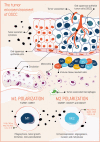Pro-Tumorigenic Macrophage Infiltration in Oral Squamous Cell Carcinoma and Possible Macrophage-Aimed Therapeutic Interventions
- PMID: 34041037
- PMCID: PMC8141624
- DOI: 10.3389/fonc.2021.675664
Pro-Tumorigenic Macrophage Infiltration in Oral Squamous Cell Carcinoma and Possible Macrophage-Aimed Therapeutic Interventions
Abstract
In Oral Squamous Cell Carcinomas (OSCC), as in other solid tumors, stromal cells strongly support the spread and growth of the tumor. Macrophages in tumors (tumor-associated macrophages or "TAMs"), can swing between a pro-inflammatory and anti-tumorigenic (M1-like TAMs) state or an anti-inflammatory and pro-tumorigenic (M2-like TAMs) profile depending on the tumor microenvironment cues. Numerous clinical and preclinical studies have demonstrated the importance of macrophages in the prognosis of patients with different types of cancer. Here, our aim was to review the role of M2-like TAMs in the prognosis of patients with OSCC and provide a state of the art on strategies for depleting or reprogramming M2-like TAMs as a possible therapeutic solution for OSCC. The Clinical studies reviewed showed that higher density of CD163+ M2-like TAMs associated with worse survival and that CD206+ M2-TAMs are involved in OSCC progression through epidermal growth factor (EGF) secretion, underlining the important role of CD206 as a marker of OSCC progression and as a therapeutic target. Here, we provide the reader with the current tools, in preclinical and clinical stage, for depleting M2-like TAMs, re-educating them towards M1-like TAMs, and exploiting TAMs as drug delivery vectors.
Keywords: CD206 receptor; drug delivery; oral squamous cell carcinoma; targeting peptides; tumor microenvironment; tumor-associated macrophage.
Copyright © 2021 Bruna and Scodeller.
Conflict of interest statement
The authors declare that the research was conducted in the absence of any commercial or financial relationships that could be construed as a potential conflict of interest.
Figures
Similar articles
-
CD206+ tumor-associated macrophages promote proliferation and invasion in oral squamous cell carcinoma via EGF production.Sci Rep. 2019 Oct 10;9(1):14611. doi: 10.1038/s41598-019-51149-1. Sci Rep. 2019. PMID: 31601953 Free PMC article.
-
Infiltration of m2 tumor-associated macrophages in oral squamous cell carcinoma correlates with tumor malignancy.Cancers (Basel). 2011 Sep 28;3(4):3726-39. doi: 10.3390/cancers3043726. Cancers (Basel). 2011. PMID: 24213108 Free PMC article.
-
Macrophages in Oral Carcinomas: Relationship with Cancer Stem Cell Markers and PD-L1 Expression.Cancers (Basel). 2020 Jul 2;12(7):1764. doi: 10.3390/cancers12071764. Cancers (Basel). 2020. PMID: 32630659 Free PMC article.
-
The Role of Macrophages in Oral Squamous Cell Carcinoma.Front Oncol. 2021 Mar 18;11:611115. doi: 10.3389/fonc.2021.611115. eCollection 2021. Front Oncol. 2021. PMID: 33816242 Free PMC article. Review.
-
The Crosstalk Between Tumor-Associated Macrophages (TAMs) and Tumor Cells and the Corresponding Targeted Therapy.Front Oncol. 2020 Nov 3;10:590941. doi: 10.3389/fonc.2020.590941. eCollection 2020. Front Oncol. 2020. PMID: 33224886 Free PMC article. Review.
Cited by
-
Phenotypes and ontogeny of senescent hepatic stellate cells in metabolic dysfunction-associated steatohepatitis.J Hepatol. 2024 Aug;81(2):207-217. doi: 10.1016/j.jhep.2024.03.014. Epub 2024 Mar 18. J Hepatol. 2024. PMID: 38508241 Free PMC article.
-
Beyond PD-L1-Identification of Further Potential Therapeutic Targets in Oral Cancer.Cancers (Basel). 2022 Apr 2;14(7):1812. doi: 10.3390/cancers14071812. Cancers (Basel). 2022. PMID: 35406584 Free PMC article.
-
Crosstalk between cancer cells and macrophages promotes OSCC cell migration and invasion through a CXCL1/EGF positive feedback loop.Discov Oncol. 2024 May 7;15(1):145. doi: 10.1007/s12672-024-00972-8. Discov Oncol. 2024. PMID: 38713320 Free PMC article.
-
Analysis of the effect of CCR7 on the microenvironment of mouse oral squamous cell carcinoma by single-cell RNA sequencing technology.J Exp Clin Cancer Res. 2024 Mar 27;43(1):94. doi: 10.1186/s13046-024-03013-y. J Exp Clin Cancer Res. 2024. PMID: 38539232 Free PMC article.
-
Crosstalk Between ROS and Autophagy in Tumorigenesis: Understanding the Multifaceted Paradox.Front Oncol. 2022 Mar 10;12:852424. doi: 10.3389/fonc.2022.852424. eCollection 2022. Front Oncol. 2022. PMID: 35359388 Free PMC article. Review.
References
-
- Rani P, Gupta A, Mehrol C, Singh M, Khurana N, Passey J. Clinicopathological Correlation of Tumor-Stroma Ratio and Inflammatory Cell Infiltrate With Tumor Grade and Lymph Node Metastasis in Squamous Cell Carcinoma of Buccal Mucosa and Tongue in 41 Cases With Review of Literature. J Cancer Res Ther (2020) 16:445–51. 10.4103/0973-1482.193113 - DOI - PubMed
-
- Pennacchiotti G, Valdés-Gutiérrez F, Alejandro González-Arriagada W, Montes HF, Maria J, Parra R, et al. . SPINK7 Expression Changes Accompanied by HER2, P53 and RB1 can be Relevant in Predicting Oral Squamous Cell Carcinoma At a Molecular Level. Sci Rep 11:6939. 10.1038/s41598-021-86208-z - DOI - PMC - PubMed
Publication types
LinkOut - more resources
Full Text Sources
Other Literature Sources
Research Materials


